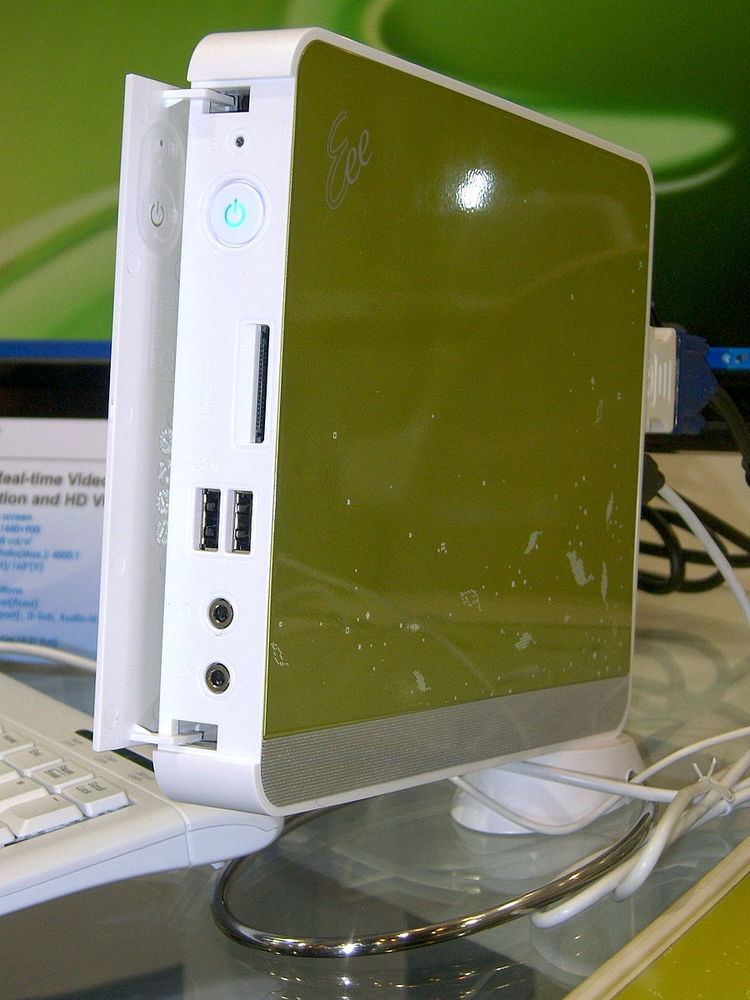 | ||
Asus Eee is a family of products by Asustek. The product family began with the release of the Eee PC subnotebook in 2007; since then, the product family has diversified into a number of PC form factors. According to the company, the name Eee derives from "the three Es," an abbreviation of its advertising slogan for the device: "Easy to learn, Easy to work, Easy to play".
Contents
Eee PC
The Asus Eee PC is a subnotebook/netbook computer. At the time of its introduction in fall 2007, it was noted for its combination of a light weight, Linux-based operating system, solid-state drive and relatively low cost. Newer models have added the option of the Windows 7 operating system, dual-core Intel Atom CPUs, and traditional hard disk drives, and have also increased in price, though they remain relatively inexpensive as laptops, and notably inexpensive for ultra-small laptops.
EeeBox PC
Asus EeeBox PC is a nettop (desktop for the internet) counterpart to the Asus Eee PC netbook (notebook for the internet). Its motherboard employs Splashtop technology called "ExpressGate" by Asus.
Eee Top
The Asus Eee Top is a touch screen computer designed by Asus and released in November 2008. Its motherboard employs Splashtop technology (an embedded Linux distribution) called "ExpressGate" by Asus. Both models feature a 1.6 GHz Atom processor, widescreen (16:9) 15.6" display, 1 GB RAM, 160GB HDD, 802.11n Wi-Fi, speakers, SD card reader and a 1.3 MP webcam with Windows XP Home modified with Asus' big-icon Easy Mode.
Eee Keyboard
ASUS Eee Keyboard is a full-size computer keyboard that has a built-in PC motherboard. It has a touchscreen in place of a conventional keypad. ASUS plans to start shipping the device in September 2009.
Eee Stick
The Eee Stick is an accessory that is expected to be bundled with specific models of the Eee PC and EeeBox PC. These specific models will also come with games that will take advantage of the features of this hardware. This accessory is very similar to the Wii Remote. The device takes two AA batteries in each of the two components (four batteries in total).
Eee PC Media Server
Asus Eee PC Media Server was shown at CES 2009.
Eee Pad MeMO
Asus MeMO 171 tablet was displayed at CES 2011, while MeMO 370T was displayed at CES 2012
Eee Pad and Eee Reader
Asus showed previews of a dual-touchscreen "Flipbook" notebook at Cebit 2009 in Germany. The company stated that the Flipbook possessed the capability of optionally displaying user interface elements in both screens both horizontally and vertically; the concept design was renamed as the "Eee Reader", rebranded as an e-book reader, and scheduled for launch in Q4 2009, which did not happen as intended. Finally, the Eee Reader was rebranded again as the "Eee Book" and scheduled for launch at the June 2010 Computex Taipei.
In addition, Asus disclosed to the press in January 2010 that a tablet computer named as "Eee Pad", using an Nvidia Tegra 2 chip, a 3G wireless connection and a 720p or 1080p resolution, would also debut at Computex. It finally materialized in March 2011 as the Eee Pad Transformer (TF101) which has an optional real (hardware) keyboard that can be connected to it. This was then Succeeded by the Asus Eee Pad Transformer Prime in December 2011.
In 2012 the newest version was released, the Asus Transformer Pad Infinity.
Eee Note
Originally released in Taiwan, featuring stand-alone note-taking/sketching capability and an E-reader. Its non-backlit screen had a long battery life, and incorporated a Wacom tablet with pressure sensitivity allowing pen-drawing on PC when connected with a micro-USB cable.
X205
Announced by Asus on September 3, 2014 at the IFA 2015 trade show and continues the Asus EEE line. It is an Intel Atom quad-core cheap Windows 8.1 notebook with 2GB of RAM and 11.6-inch non-touch display. The EeeBook X205 was to come in black, white, gold and red when it launched in the United States and Europe in November 2014.
E202
The EeeBook E202 features Intel Celeron or Intel Pentium processors, up to 4GB of DDR3L memory, an 11.6" WXGA (1366x768) display. In terms of i/o, it has 1 x Headphone-out jack (Audio-in Combo), 1 x USB 3.0 port, 1 x USB 2.0 port, 1 x USB-C Gen 1 (up to 5 Gbit/s) and 1 x micro HDMI.
E403
The EeeBook E403 features Intel Celeron or Intel Pentium processors, up to 4GB of DDR3L memory, an 14 (1366x768) display. In terms of i/o, it has 1 x COMBO audio jack, 1 x USB 3.0 port, 1 x USB 2.0 port, 1 x USB-C Gen 1 (up to 5 Gbit/s) and 1 x HDMI.
